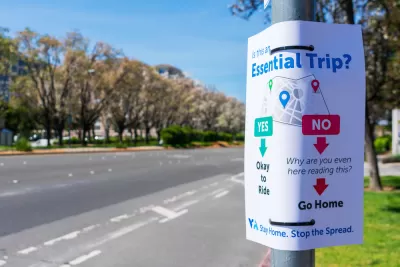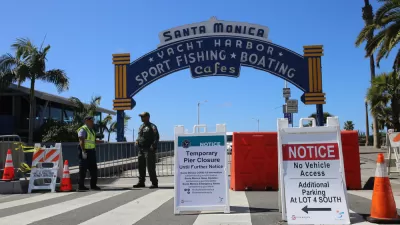Ridership is the wrong way to think about the importance of public transit.

Workers keeping the nation's essential industries and services going are still using transit, but there isn't much good news or positive thinking regarding public transit during the COVID-19 pandemic.
Transit ridership is in free-fall, plunging transit agencies all over the country into an unprecedented fiscal crisis. The CARES Act federal stimulus offered some relief for the fiscal situation facing transit agencies, but the long-term prognosis is completely uncertain. In New York City, the coronavirus has had tragic consequences for transit operators.
This tweet by Richard Florida sums up what most people are probably assuming about the prospects of maintaining public support for transit during and after the pandemic.
People will be scared of subways, busses & trains for some time, with implications beyond transit systems.
They will turn to cars, congestion will increase.
Wonderful transit-connected suburbs may suffer.
Demand for close-in walkable, bikeable neighborhoods will grow. https://t.co/sPJrly2qP7— Richard Florida (@Richard_Florida) April 9, 2020
So, what can be said in defense of the operation and use of public transit in a public health crisis like the COVID-19 pandemic? According to Jarret Walker, a transit planning consultant involved in some of the most innovative bus redesign projects in the United States during the past decade, transit is not just essential in these uncertain times, it's more important than ever.
"The goal of transit, right now, is neither competing for riders nor providing a social service for those in need. It is helping prevent the collapse of civilization," writes Walker for CityLab.
The catch, according to Walker, is that public transit has always been playing that critical role.
Those “essential service” workers, who are overwhelmingly low-income, have always been there, moving around quietly in our transit systems, keeping our cities functioning. Too often, we have patronized them by calling them needy or dependent when in fact everything would collapse if they couldn’t get to work.
Walker's purpose in writing this article is not to look at the crisis with rose-colored glasses, or diminish assessments of the long road back to recovery for transit agencies. Walker doesn't even suggest that sentiments like those expressed above by Richard Florida are wrong. Walker does suggest its time for everyone, first and foremost journalists, to reframe the discussion away from questions about ridership, and toward a better understanding of the essential service provided by transit agencies.
FULL STORY: In a Pandemic, We're All 'Transit Dependent'

Alabama: Trump Terminates Settlements for Black Communities Harmed By Raw Sewage
Trump deemed the landmark civil rights agreement “illegal DEI and environmental justice policy.”

Planetizen Federal Action Tracker
A weekly monitor of how Trump’s orders and actions are impacting planners and planning in America.

Why Should We Subsidize Public Transportation?
Many public transit agencies face financial stress due to rising costs, declining fare revenue, and declining subsidies. Transit advocates must provide a strong business case for increasing public transit funding.

Understanding Road Diets
An explainer from Momentum highlights the advantages of reducing vehicle lanes in favor of more bike, transit, and pedestrian infrastructure.

New California Law Regulates Warehouse Pollution
A new law tightens building and emissions regulations for large distribution warehouses to mitigate air pollution and traffic in surrounding communities.

Phoenix Announces Opening Date for Light Rail Extension
The South Central extension will connect South Phoenix to downtown and other major hubs starting on June 7.
Urban Design for Planners 1: Software Tools
This six-course series explores essential urban design concepts using open source software and equips planners with the tools they need to participate fully in the urban design process.
Planning for Universal Design
Learn the tools for implementing Universal Design in planning regulations.
Caltrans
Smith Gee Studio
Institute for Housing and Urban Development Studies (IHS)
City of Grandview
Harvard GSD Executive Education
Toledo-Lucas County Plan Commissions
Salt Lake City
NYU Wagner Graduate School of Public Service




























